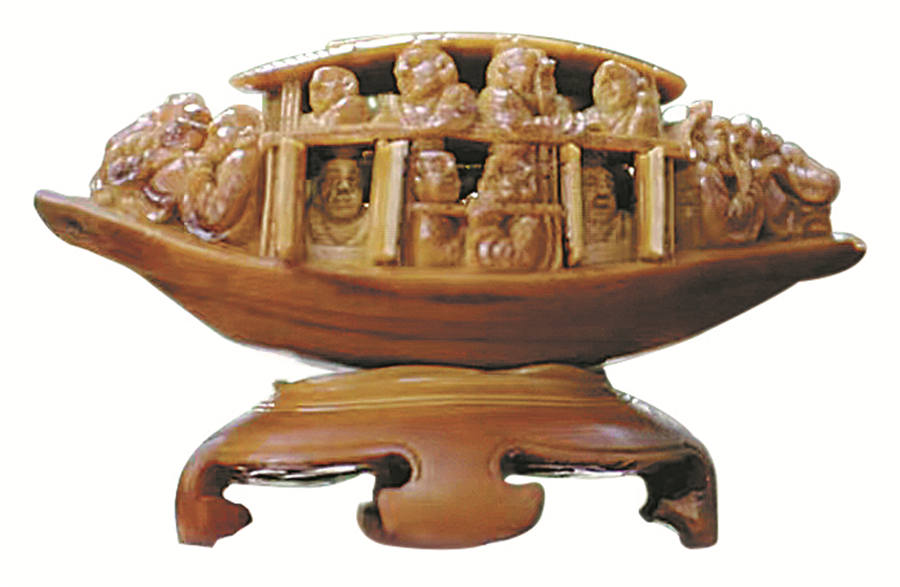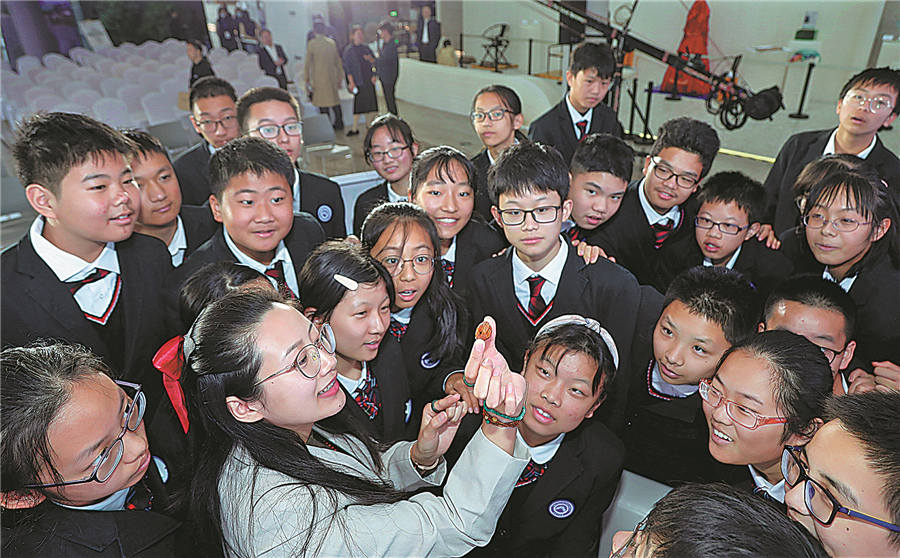May 19, 2022
BEIJING – With incredible skill and dexterity, artist conjures up miniature images on the stones of peaches, apricots and Chinese olives, Yang Feiyue reports.
Zhu Mengjia has found a new world in the smallest and unlikeliest of places: fruit pits. The 29-year-old from Guangfu town in Suzhou city, East China’s Jiangsu province, has been sculpting ingenious creations out of the challengingly hard, tiny and rugged pits over the years.
With her touch, as if by magic, vivid images of animals, plants, boats and garden views emerge.
Examined using a magnifying glass, the delicate sculptures on the fruit pits still look vivid, confirming her flawless technique.
“I usually spend five hours a day working on them,” Zhu says.
But when things get busy, she has to toil away for more than 10 hours without a break.
Guangfu fruit pit carving was named a national intangible cultural heritage in 2008.
Earliest examples of the art form date back to the Song Dynasty (960-1279).The Chinese folk handicraft enjoyed rising popularity in the Ming (1368-1644) and Qing (1644-1911) dynasties, when the royal families wore the carvings as an aristocratic decoration.
The pits of peach, apricot, walnut, and Chinese olive are the most prevalently used, and upon which minute images of Buddha, nature, or the Chinese zodiac that are said to repel evil spirits, are carved.

A decorative boat carved by Zhu. [Photo provided to China Daily]
“On the premise of maintaining the shape of the fruit pit, the carvings stand out for their precision, fineness, strangeness and cleverness, presenting unique local characteristics,” she says.
“As a young artisan, I’d like to create my own world in the small space provided by the fruit pits.”
Born and bred in Guangfu, a small town near Taihu Lake, Zhu was exposed to traditional art forms from an early age.
Her hometown boasts a long tradition of fruit pit, jade, Buddha and sandalwood carvings.
“I have relatives who engage in those arts,” she says.
Zhu developed a predisposition toward handiwork and has learned to play musical instruments, including the guzheng (Chinese zither), a plucked stringed instrument.
She made her way to Nanjing University of the Arts in 2012, focusing on art and design.
It was during one summer vacation that the college student stumbled upon the challenge and charm of fruit pit carving.
At that time, she visited Xu Zhongying, a national fruit pit carving inheritor, with the intention of re-creating some of her own paintings on the fruit pits-she thought, at the time, that fruit pit carving was not that hard.

Zhu engages in fruit pit carving. [Photo provided to China Daily]
It didn’t take long before Zhu realized how hard the natural fruit pits were and that it took far more than just finger strength to carve into them.
Even with the sharpened tools, it takes a long time of practicing to understand the use of the tools and to get a knack for coordinating the hands, she says.
The complexity of the art aroused Zhu’s enthusiasm.
She made the decision to come back to Guangfu after graduation.
“I had doubts, especially after seeing my classmates landing jobs in big cities,” she says.
“But after further thought, I knew I had to do something I wanted.”
Zhu then officially became Xu’s apprentice and systematically explored the craftsmanship of fruit pit carving.
It’s no easy job making the carvings and telling whole stories on the small pits.
It takes multiple steps from selection of the fruit pit, to the design, drawing and carving-including the various techniques that cover gouging, polishing and scraping.
A dozen tools have to be applied, including files, burins and hand drills. “You can’t skip a step, and the carving has to be meticulous and precise,” Zhu says.
“A small slip, or a tiny error, will be magnified and throw things back to the drawing board.”
Zhu admits that she was a bit impatient in the beginning.

She gives a presentation to youngsters at a local museum to popularize the art. [Photo provided to China Daily]
Thanks to Xu’s tutoring and her own continuous practice, Zhu gradually found the peace and patience required to produce her artistic creations.
The more she learned, the more she felt she made the right choice.
“Urban prosperity is appealing, but rural development and the inheritance of such craftsmanship needs more young vigor,” she says, adding that she wants to tell stories about her hometown via fruit pit carving.
In 2014, Zhu opened her own studio, but she soon suffered setbacks.
Carving machines hit the market and pit artists suddenly found that the technique they had toiled to master and the skill they had built up over the years were no longer in such high demand.
“It was very tough, and I had to run classes to teach children to keep the studio running,” she says.
But, as in the case with all art, the discerning eye could tell the difference between a machine carving and that of a trained hand.
“The chill passed quickly,” Zhu says.
The experience woke Zhu up to the fact that a lack of young consumers is hampering the potential prosperity of her trade.
She then started to think about innovative ways to bring pit carving to young people’s attention.
Zhu has since committed herself to popularizing the traditional art among young people and turning its inheritance into a prevailing taste.
The art training in her college years enabled her to integrate modern elements into the traditional carving and cater to the younger generation’s aesthetic appreciation.
She has created cute Chinese zodiac animals and the majestic Suzhou gardens on fruit pits, as well as some with elements from popular sci-fi movies.
Those works have managed to appeal to young people, as shown by her regular visits to local primary and middle schools to promote the art.
“They show great interest in making their own fruit pit carvings afterward,” Zhu says.

She poses with college students at a workshop for the craft in Nanjing, Jiangsu. [Photo provided to China Daily]
To date, Zhu says she has divided her attention equally to promoting the art form and carving her own creations.
In Zhu’s opinion, the key to pit carving is expressing ideas.
“It’s the most difficult,” Zhu says.
“Sometimes I feel like artwork has a soul and one can see the creator’s views toward the world and life.”
In her Dreamland series, Zhu conveyed her sense of loss and struggle toward her future path right after graduation.
The series features human figures that cover their eyes with their hands or have a contemplative look.
It was an inspiration from a world of explosive information, where people could be interrupted by various noises, she explains.
“I tried to present the abstract idea of calling people to face up to their inner voice and learn about independent thinking,” Zhu says.
The works managed to reflect the inner world of people and got nominated at the Zijin Award Cultural Creative Design Competition hosted by the Jiangsu provincial government in 2017.
In 2018, Zhu’s Suzhou Garden series was displayed during the China culture week in Tel Aviv in Israel.
“The girl is smart and willing to think outside the box,” Xu says about Zhu.
“It was an extraordinary thing that she switched her career to fruit pit carving right after college and has carried it on,” adds her master.
Xu speaks highly of Zhu’s creativity, shown in her works featuring the motifs pertaining to the founding of the Communist Party of China and its emblem for the 18th national congress of the Communist Youth League of China.
As Zhu’s works have been increasingly recognized by the public, she has been more strict with herself.
She has challenged herself to make full use of defects on some fruit pits, which might have been discarded before.
“Abnormal white spots will happen on some red or yellow fruit pits,” she explains.
She seeks to turn those spots into part of her creation, such as the flame of a candle next to an old weaving woman.
Somehow, it has become her own style.
Speaking about the future, Zhu says she will continue to explore pit carving that is a distinctive characteristic of her hometown.
“The carving also benefits the creator, since it opens a dialogue with the heart, releases pressure and concentrates the mind on details,” she says.


